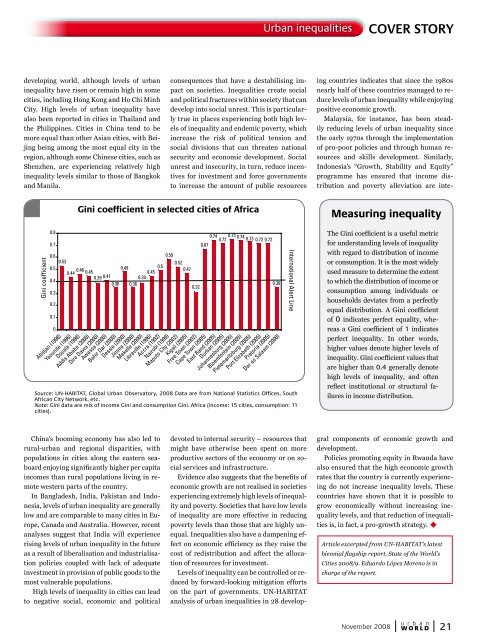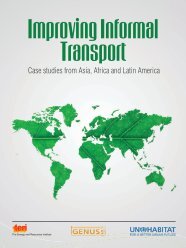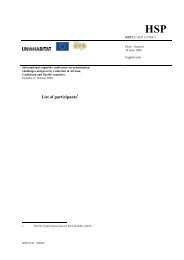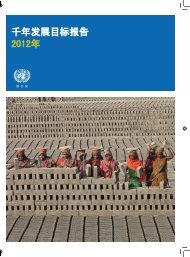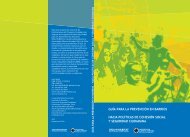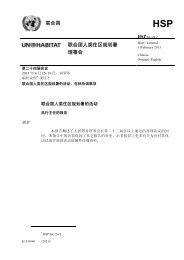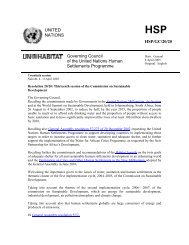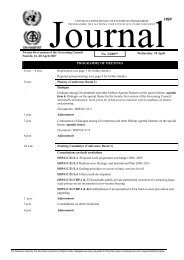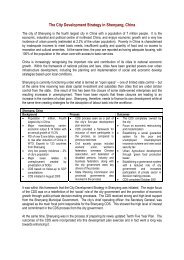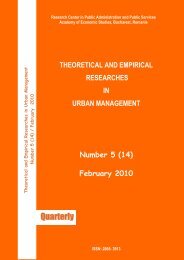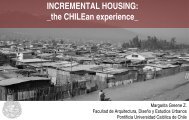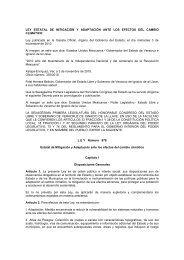Harmonious cities - UN-Habitat
Harmonious cities - UN-Habitat
Harmonious cities - UN-Habitat
Create successful ePaper yourself
Turn your PDF publications into a flip-book with our unique Google optimized e-Paper software.
developing world, although levels of urban<br />
inequality have risen or remain high in some<br />
<strong>cities</strong>, including Hong Kong and Ho Chi Minh<br />
City. High levels of urban inequality have<br />
also been reported in <strong>cities</strong> in Thailand and<br />
the Philippines. Cities in China tend to be<br />
more equal than other Asian <strong>cities</strong>, with Beijing<br />
being among the most equal city in the<br />
region, although some Chinese <strong>cities</strong>, such as<br />
Shenzhen, are experiencing relatively high<br />
inequality levels similar to those of Bangkok<br />
and Manila.<br />
China’s booming economy has also led to<br />
rural-urban and regional disparities, with<br />
populations in <strong>cities</strong> along the eastern seaboard<br />
enjoying significantly higher per capita<br />
incomes than rural populations living in remote<br />
western parts of the country.<br />
In Bangladesh, India, Pakistan and Indonesia,<br />
levels of urban inequality are generally<br />
low and are comparable to many <strong>cities</strong> in Europe,<br />
Canada and Australia. However, recent<br />
analyses suggest that India will experience<br />
rising levels of urban inequality in the future<br />
as a result of liberalisation and industrialisation<br />
policies coupled with lack of adequate<br />
investment in provision of public goods to the<br />
most vulnerable populations.<br />
High levels of inequality in <strong>cities</strong> can lead<br />
to negative social, economic and political<br />
Urban inequalities<br />
consequences that have a destabilising impact<br />
on societies. Inequalities create social<br />
and political fractures within society that can<br />
develop into social unrest. This is particularly<br />
true in places experiencing both high levels<br />
of inequality and endemic poverty, which<br />
increase the risk of political tension and<br />
social divisions that can threaten national<br />
security and economic development. Social<br />
unrest and insecurity, in turn, reduce incentives<br />
for investment and force governments<br />
to increase the amount of public resources<br />
0.7<br />
0.6<br />
0.53<br />
0.44 0.46 0.45<br />
0.39 0.41<br />
0.8<br />
0.74 0.75 0.74<br />
0.72 0.73 0.72 0.72<br />
0.67<br />
0.59<br />
0.5<br />
0.49<br />
0.5<br />
0.45<br />
0.39<br />
0.4<br />
0.36 0.36<br />
0.3<br />
0.52<br />
0.47<br />
0.32<br />
0.36<br />
Gini coefficient<br />
0.2<br />
0.1<br />
0<br />
Gini coefficient in selected <strong>cities</strong> of Africa<br />
Abidjan (1998)<br />
Yaounde (1996)<br />
Douala (1996)<br />
Addis Ababa (2000)<br />
Dire Dawa (2000)<br />
Awassa (2000)<br />
Bahir Dar (2000)<br />
Dessie (2000)<br />
Jimma (2000)<br />
Mekelle (2000)<br />
Libreville (1996)<br />
Accra (1992)<br />
Nairobi (1999)<br />
Maputo City (2002)<br />
Kigali (2005)<br />
Free Town (2002)<br />
Cape Town (2005)<br />
East Rand (2005)<br />
Durban (2005)<br />
Johannesburg (2005)<br />
Bloemfontein (2005)<br />
Pietemaritzburg (2005)<br />
Port Elizabeth (2005)<br />
Pretoria (2005)<br />
Dar es Salaam (2000)<br />
Source: <strong>UN</strong>-HABITAT, Global Urban Observatory, 2008 Data are from National Statistics Offices, South<br />
African City Network, etc.<br />
Note: Gini data are mix of income Gini and consumption Gini. Africa (income: 15 <strong>cities</strong>, consumption: 11<br />
<strong>cities</strong>).<br />
International Alert Line<br />
devoted to internal security – resources that<br />
might have otherwise been spent on more<br />
productive sectors of the economy or on social<br />
services and infrastructure.<br />
Evidence also suggests that the benefits of<br />
economic growth are not realised in societies<br />
experiencing extremely high levels of inequality<br />
and poverty. Societies that have low levels<br />
of inequality are more effective in reducing<br />
poverty levels than those that are highly unequal.<br />
Inequalities also have a dampening effect<br />
on economic efficiency as they raise the<br />
cost of redistribution and affect the allocation<br />
of resources for investment.<br />
Levels of inequality can be controlled or reduced<br />
by forward-looking mitigation efforts<br />
on the part of governments. <strong>UN</strong>-HABITAT<br />
analysis of urban inequalities in 28 develop-<br />
COVER STORY<br />
ing countries indicates that since the 1980s<br />
nearly half of these countries managed to reduce<br />
levels of urban inequality while enjoying<br />
positive economic growth.<br />
Malaysia, for instance, has been steadily<br />
reducing levels of urban inequality since<br />
the early 1970s through the implementation<br />
of pro-poor policies and through human resources<br />
and skills development. Similarly,<br />
Indonesia’s “Growth, Stability and Equity”<br />
programme has ensured that income distribution<br />
and poverty alleviation are inte-<br />
Measuring inequality<br />
The Gini coefficient is a useful metric<br />
for understanding levels of inequality<br />
with regard to distribution of income<br />
or consumption. It is the most widely<br />
used measure to determine the extent<br />
to which the distribution of income or<br />
consumption among individuals or<br />
households deviates from a perfectly<br />
equal distribution. A Gini coefficient<br />
of 0 indicates perfect equality, whereas<br />
a Gini coefficient of 1 indicates<br />
perfect inequality. In other words,<br />
higher values denote higher levels of<br />
inequality. Gini coefficient values that<br />
are higher than 0.4 generally denote<br />
high levels of inequality, and often<br />
reflect institutional or structural failures<br />
in income distribution.<br />
gral components of economic growth and<br />
development.<br />
Policies promoting equity in Rwanda have<br />
also ensured that the high economic growth<br />
rates that the country is currently experiencing<br />
do not increase inequality levels. These<br />
countries have shown that it is possible to<br />
grow economically without increasing inequality<br />
levels, and that reduction of inequalities<br />
is, in fact, a pro-growth strategy. u<br />
Article excerpted from <strong>UN</strong>-HABITAT’s latest<br />
biennial flagship report, State of the World’s<br />
Cities 2008/9. Eduardo López Moreno is in<br />
charge of the report.<br />
u r b a n<br />
November 2008 WORLD 21


